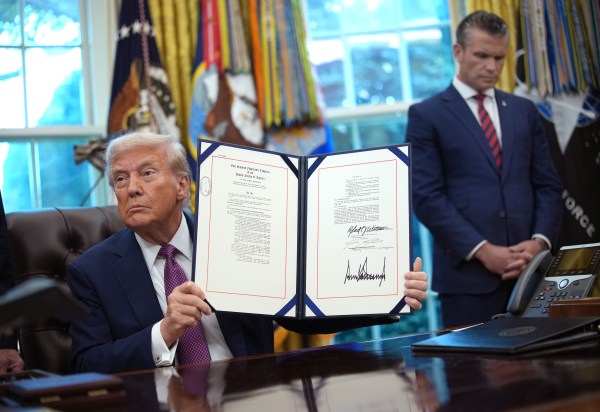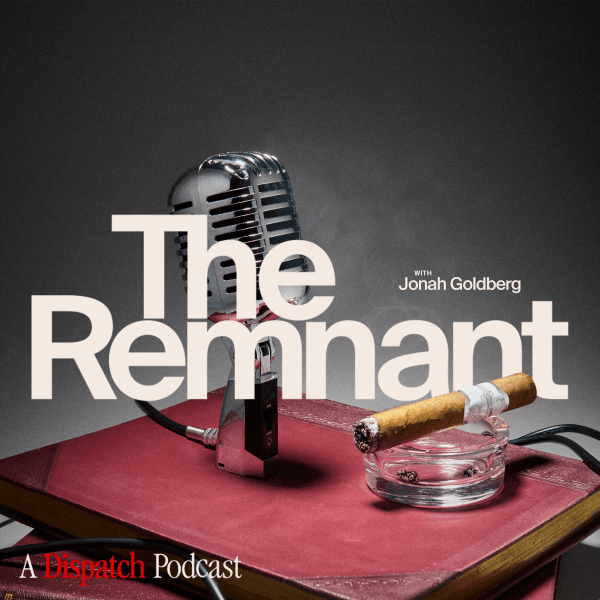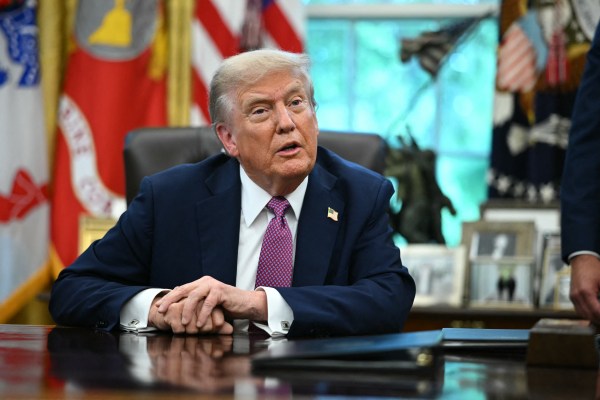Short Answer
This was a cross-wave election and the Democratic wave swamped the Republican one. The result looks a lot like the status quo on the surface, but there is a lot of turbulence underneath. Democratic candidates defied history, presidential approval numbers, and economic indicators to maintain control of the Senate and hold Republicans to the slimmest of majorities in the House. And while we will dive into some of the potential explanations for that, the simplest one is that Democrats didn’t exactly win, but Republicans definitely lost.
Long Answer
Abortion. Candidate Quality. Trump. Let’s take them one at a time.
Abortion. I’ve been saying for weeks that it would be hard to know what role abortion played in these midterms because winning and losing isn’t enough. But we have at least a few reasons to think it helped Democrats.
First, compare the ballot-measure results in Michigan to the governor’s race. Gretchen Whitmer won with 54 percent of the vote; the ballot measure to amend the state constitution and “establish a new individual right to reproductive freedom” won with 57 percent of the vote. But about 85,000 fewer people voted for the ballot measure than in the governor’s race. So maybe it’s a wash, right? Nope. Whitmer got 2,427,985 votes. The ballot measure got 2,480,000. So even though almost 2 percent of the gubernatorial voters didn’t vote either way on the ballot question, the pro-choice side got more votes. This almost certainly means the ballot measure—i.e., abortion rights—drove turnout for Whitmer and not the other way around.
Second, the pro-life ballot measure in Kentucky lost. The ballot measure wasn’t like a heartbeat bill or a 15-week ban. It was actually just the reverse of the Michigan one. It would have clarified that there was no right to abortion, or any requirement to fund abortion, in the state constitution—pretty mild as pro-life efforts go. Yet 52 percent voted against it. And the “no” vote outperformed the Democrat at the top of the ticket. Only 563,676 people voted for Charles Booker in his race to unseat Sen. Rand Paul, but almost 200,000 additional folks voted against changing the state constitution. Even though it is a deep red state at the presidential level, like Kansas, Kentucky has a Democratic governor. So it’s not that I think this data is definitive on where the country is on the abortion question (though I certainly think it should bear some weight), but it definitely tells me something about whether abortion helped drive Democratic turnout.
Lastly, there’s the turnout numbers. The initial excitement over youth turnout appears to have been pretty overblown. See, e.g., every rant I’ve ever done on early exit polls. In fact, it looks like young voters turned out in higher numbers in 2018. But I’ll be keeping my eye on the number for young female voters in some of these states. At least one poll has 77 percent of young women in Pennsylvania voting for Fetterman. Biden only got 70 percent in 2020. That isn’t enough to account for all of Fetterman’s 4-point win, but it seems likely that abortion messaging could account for the bump within that demographic.
Candidate quality. Back in the summer, Mitch McConnell said, “Senate races are just different. … Candidate quality has a lot to do with the outcome.” It’s funny to see people blaming him for these losses now. The theory is that by saying it out loud, he demoralized GOP voters and donors and thus cost Republicans the Senate. I saw one tweet accusing McConnell of caring only about “money and power”—why that's supposed to mean he didn’t want to be majority leader is unclear. To be clear, Republicans lost these Senate races by a lot in some cases. New Hampshire ended up D+9 and Arizona was D+5. I simply do not buy the fact that 130,000 voters in Arizona—the margin between Kelly and Masters—even know who Mitch McConnell is, let alone what he said. As for the donors, if McConnell were to blame for dampening enthusiasm, I’d expect to see a bigger divide between small and big donors. Big donors are the ones that follow what “the elites” are saying around D.C. watering holes because that’s who goes to high-dollar fundraising events. Small dollar donors are giving in response to social media posts and direct mail that is far more likely to be attacking McConnell as part of the establishment. And yet … these are the numbers through mid-October.
It’s kind of mind blowing to look at. Masters did better with big donors as a percentage of his overall haul compared with Kelly but he raised—not a joke, folks—only 15 percent of the money that Kelly brought in. Bear in mind that outside groups, including McConnell’s, spent tens of millions on his candidacy, so their overall spending wasn’t that far apart. But this is about candidate quality, and candidate fundraising is a decent benchmark of whether a candidate is any good.
The result wasn’t just Republican losses, but a whole lot of ticket splitters who voted for Republican governors and Democratic Senate candidates. When I say “a whole lot,” we’re actually talking about pretty small raw numbers of voters, but they made all the difference. Gov. Brian Kemp outran Herschel Walker by 8 points in Georgia, Gov. Chris Sununu outran Don Bolduc by 12 points in New Hampshire, and Gov. Mike DeWine outran J.D. Vance by 9 points in Ohio. Equally important, this wasn’t partisan and it wasn’t just incumbents: Democratic gubernatorial nominee Josh Shapiro outran John Fetterman by 5 points in Pennsylvania. In Washington state, Republican Jaime Herrera Beutler won the 3rd Congressional District by 13 points in 2020, but Joe Kent beat her in the primary and then lost the seat. Candidate quality matters—and Republicans had more poor quality candidates whom they couldn’t pull over the finish line.
Trump. Now that Kari Lake has lost her race in Arizona, every single candidate from the “stop the steal” slate of MAGA secretary of state or gubernatorial candidates has lost. On the other hand, Kemp sailed right on through. So did Georgia Secretary of State Brad Raffensperger.
In fact, the score card was bleak for Trump overall. As I’ve said before, the influence of a movement isn’t measured in primaries but in general elections. It doesn’t matter how many yards you pick up if you never get the ball in the end zone.
The problem was clearly in the primaries. Of the 10 House Republicans who voted to impeach Trump, only two survived to a general election. But of those two? Newhouse won his race and Valadao is leading as of the time of publishing this (yes, somehow California still is only about halfway through counting its ballots: eye roll). Not only did Trump influence who won these primaries (see above) but he also influenced who was even willing to put their hat in the ring. Sununu didn’t run for the Senate seat in New Hampshire; Ducey didn’t run in Arizona.
And this is where we get to the other issue on the ballot: democracy. Like abortion, it’s hard to point to any definitive data that will prove this was a lynchpin issue for Democrats, but it’s also clear to me that abortion alone can’t account for some of the spread based on even the roughest margins in these exit polls. It stands to reason that these lean-Republican voters who split their ticket were wary of electing candidates who may or may not be willing to abide by election results. “Kelly is lame but at least I know I can vote him out in six years!”
Lastly, as I mentioned last week, Trump put Republicans at a serious operational disadvantage. In previous elections, mail ballots slightly favored Republicans. But both parties would try to bank as many early and absentee votes as possible (called “AB chase” in the business) so they could concentrate all of their Election Day volunteer firepower on the low-propensity holdouts. Thanks to Trump (and COVID), Democrats have gotten rocket fuel behind their efforts. Their volunteer-per-voter ratio on Election Day is shrinking by leaps and bounds.
But Republicans are now voting disproportionately on Election Day because Trump told them the only way to “stop the steal” was if Democrats didn't know how many votes they needed to win. Of course, this makes every GOP campaign’s turnout operation much, much more difficult. But it also deprives GOP campaigns of a lot of information for their voter models to know whether they are running behind expectations in key precincts well before Election Day.
If this election had happened in 2014, Republicans would have known weeks ago that they had a problem because they would have been way behind in their AB chase models. Instead, they found out about three hours after the polls closed.
And perhaps here is a good place to once again debunk the whole “but maybe the election really was stolen this time” thing. No. It wasn’t.
Handful of Senators Push to Delay Leadership Elections
When Senate Republicans elect one of their colleagues to serve as chairman of the National Republican Senatorial Committee, they hand that person the reins to raise the money for their own races and control the NRSC’s campaign war chest. That person has the power to determine where, when, and how campaign money is spent throughout an election cycle and gets a lot of quality time with some of the top Republican donors in the country. Mitch McConnell had the job for the 2000 cycle. John Cornyn had it for 2012. Phill Gramm, Bill Frist, and Elizabeth Dole all held the post at one point. It’s only a two-year job, but it’s an audition of sorts. This person works in tandem with the Senate Republican majority/minority leader, who runs the conference’s leadership super PAC—the Senate Leadership Fund—and is usually the public face of the Republican Senate reelection efforts.
In some cases, this setup can work seamlessly. But while defeat is a motherless child, tensions were roiling between NRSC Chairman Rick Scott and McConnell well before last week and now everyone is taking shots.
Scott isn’t up for reelection as NRSC chair. It’s a one-cycle job. But McConnell sure is.
Audrey and Price asked senators Monday evening how the McConnell-Scott feud is playing into some Senate Republicans’ call for a delay in this week’s Senate leadership elections, when members are slated to elect their colleagues to a number of different posts (minority leader, NRSC chair, policy chair, etc.) Here’s a snippet of their story:
“Lingering disagreements over how the NRSC and the McConnell-aligned SLF spent their campaign resources throughout the cycle have exacerbated these tensions. Whereas Scott has come under fire for spending too much of the NRSC’s limited cash at the beginning of the cycle, McConnell has taken hits from Scott and others for publicly criticizing “candidate quality” of this year’s slate of GOP Senate hopefuls and for investing in a few Republican Senate primary candidates more likely to support him as leader. The SLF also complained that McConnell had to spend heavily in states like Ohio and Pennsylvania where Republican Senate candidates raised paltry funds early in the cycle.”
Rumors were circulating for months that Scott had his eye on a certain Casa Blanca before the election, believing that he was about to be able to take credit for massive Republican victories potentially in states like Colorado and New Hampshire. His allies were touting Scott’s record of never losing a race and his killer political instincts that McConnell just didn’t appreciate. But, poor Icarus, it was not to be. And in that sense, the McConnell team has one big advantage over Scott these days: They saw this coming.
Catch Up: Ballot Initiatives You May Have Missed
RCV takes center stage in Nevada: In one of the more fascinating ballot initiatives this cycle, Nevadans look poised to adopt open primaries and a ranked choice voting system in their state. Similar to Alaska’s new system that combines a nonpartisan primary with a ranked choice voting general election, this means that in all gubernatorial, congressional, state legislative, and administrative elections, Nevada voters will be able to vote for candidates from any party affiliation in open primaries, and the top five finishers in the open primary will advance to the general, where the winner can rank candidates in order of preference (or choose one or none of the above!).
The effort passed by more than 5 points, with 95 percent of votes reporting as of Tuesday afternoon. But it requires a change to Nevada’s constitution, which in Nevada means voters will have to vote on it again in 2024. (Per Ballotpedia, “In Nevada, initiated constitutional amendments need to be approved in two even-numbered election years, meaning that Question 3 needs to be approved in 2022 and 2024 to amend the Nevada Constitution. As Question 3 was approved in 2022, a second vote will be held on November 5, 2024.”)
Should that effort succeed, the new election system would be implemented in 2026. This would be the first swing state to try such a system and would be a big test for RCV proponents who argue that the system should encourage more interesting candidates to run, more centrist candidates to win, and more bipartisan governing.
(Check out our thoughts from last year on ranked choice voting here, where we used New York City’s mayoral election to discuss how the system might affect polling, partisanship, and the importance of name recognition in winning elections nationwide.)
Pro-choice activists win big in midterms: Voters in Vermont, California, and Michigan passed ballot initiatives to constitutionally enshrine the right to abortion on the state level. And in Montana, voters rejected an initiative that would have required health care providers to “take necessary actions to preserve the life of a born-alive infant” at “any stage of development.” Had it passed, any health care providers who violated this law could have been hit with $50,000 in fines or up to 20 years in prison time.
(Andrew’s got a midterm-related story on the future of the pro-life movement here.)
Four states ban slavery and involuntary servitude: When the 13th Amendment passed in 1865, the U.S. banned ban slavery and involuntary servitude “except as punishment for a crime whereof the party shall have been duly convicted.” Voters in Alabama, Tennessee, Vermont, and Oregon voted to close that criminal punishment loophole on the state level, a move that lays the groundwork for criminal justice activists to challenge prison labor laws that require those behind bars to work for pennies on the dollar. A similar ballot initiative failed in Louisiana, where former proponents of the initiative ultimately urged voters to vote against it on the grounds that the language of the amendment was too ambiguous.








Please note that we at The Dispatch hold ourselves, our work, and our commenters to a higher standard than other places on the internet. We welcome comments that foster genuine debate or discussion—including comments critical of us or our work—but responses that include ad hominem attacks on fellow Dispatch members or are intended to stoke fear and anger may be moderated.
With your membership, you only have the ability to comment on The Morning Dispatch articles. Consider upgrading to join the conversation everywhere.